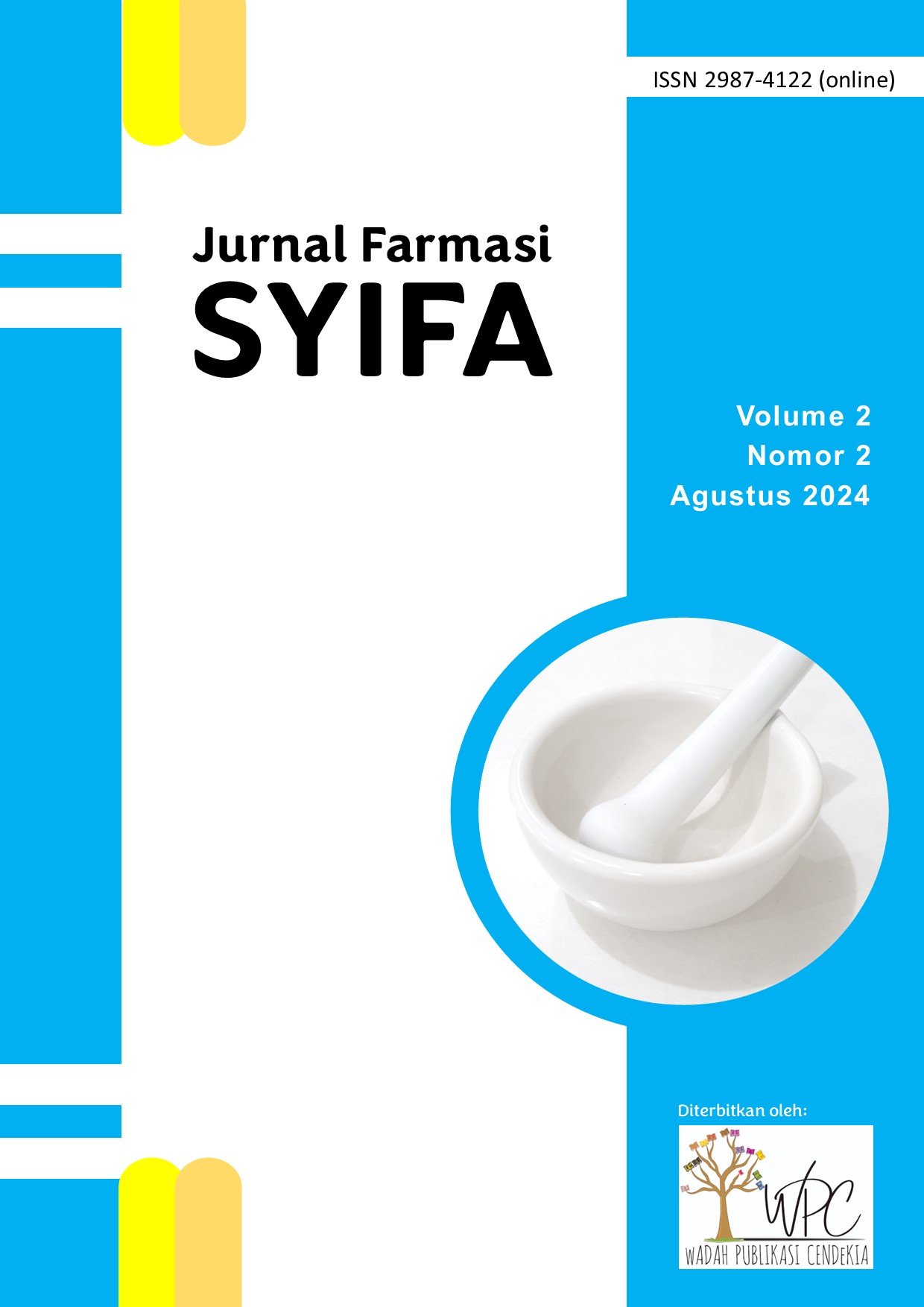Peptida Bioaktif: Menjelajahi Potensi Dan Tantangan Menuju Pangan Masa Depan
DOI:
https://doi.org/10.63004/jfs.v2i2.461Kata Kunci:
Nutrasetikal, Pangan Fungsional, Hidrolisis EnzimatisAbstrak
Peptida bioaktif merupakan fragmen protein spesifik yang tidak hanya memiliki fungsi sebagai nutrisi, namun juga memiliki efek positif pada fungsi, kondisi dan kesehatan tubuh. Peptida bioaktif dapat terbentuk selama proses proteolisis baik melalui hidrolisis enzimatik in vitro, fermentasi, maupun pemecahan selama pencernaan makanan di saluran cerna. Peptida bioaktif memiliki berbagai manfaat pada kesehatan manusia dengan mempengaruhi sistem pencernaan, endokrin, kardiovaskular, syaraf dan imunitas. Beberapa jenis peptida bioaktif juga telah diteliti dan diketahui memiliki aktivitas antihipertensi, antioksidan, imunomodulator, antimikroba, antihiperlipidemia, sitomodulator dan antigenotoksik. Peptida bioaktif juga merupakan komponen yang fleksibel dalam penggunaannya dikarenakan variasi rantai samping yang dapat berinteraksi dan bekerja pada berbagai jenis lingkungan. Beberapa tantangan dalam penggunaan bioaktif peptida adalah lingkungan asam pada lambung serta efek dari enzim protease pada lambung dan usus yang tentunya akan berdampak terhadap ketersediaan hayatinya. Selain itu, meskipun peptida dapat mencapai sirkulasi sistemik, peptida dapat mengalami inaktivasi yang menyebabkan peptida kehilangan aktivitasnya dan hanya berperan sebagai nutrisi. Peptida dengan berat molekul besar juga dapat mengalami kesulitan dalam proses penyerapannya di usus, menyebabkan hilangnya peptida yang bermanfaat dari sistem pencernaan. Meskipun begitu, peptida bioaktif memiliki potensi besar yang dapat dikembangkan. Review ini berfokus pada potensi peptida bioaktif sebagai pangan fungsional dan nutrasetikal.
Unduhan
Referensi
Akbarian, M., Khani, A., Eghbalpour, S., & Uversky, V. N. (2022). Bioactive Peptides: Synthesis, Sources, Applications, and Proposed Mechanisms of Action. International Journal of Molecular Sciences, 23(3), Article 3. https://doi.org/10.3390/ijms23031445 DOI: https://doi.org/10.3390/ijms23031445
Akitomi, H., Tahara, Y., Yasuura, M., Kobayashi, Y., Ikezaki, H., & Toko, K. (2013). Quantification of tastes of amino acids using taste sensors. Sensors and Actuators B: Chemical, 179, 276–281. https://doi.org/10.1016/j.snb.2012.09.014 DOI: https://doi.org/10.1016/j.snb.2012.09.014
Arihara, K., Nakashima, Y., Mukai, T., Ishikawa, S., & Itoh, M. (2001). Peptide inhibitors for angiotensin I-converting enzyme from enzymatic hydrolysates of porcine skeletal muscle proteins. Meat Science, 57(3), 319–324. https://doi.org/10.1016/S0309-1740(00)00108-X DOI: https://doi.org/10.1016/S0309-1740(00)00108-X
Assmann, G., Buono, P., Daniele, A., Della Valle, E., Farinaro, E., Ferns, G., Krogh, V., Kromhout, D., Masana, L., Merino, J., Misciagna, G., Panico, S., Riccardi, G., Rivellese, A. A., Rozza, F., Salvatore, F., Salvatore, V., Stranges, S., Trevisan, M., … Vetrani, C. (2014). Functional foods and cardiometabolic diseases: International Task Force for Prevention of Cardiometabolic Diseases. Nutrition, Metabolism and Cardiovascular Diseases, 24(12), 1272–1300. https://doi.org/10.1016/j.numecd.2014.10.010 DOI: https://doi.org/10.1016/j.numecd.2014.10.010
Bernardini, R. D., Mullen, A. M., Bolton, D., Kerry, J., O’Neill, E., & Hayes, M. (2011). Assessment of the angiotensin-I-converting enzyme (ACE-I) inhibitory and antioxidant activities of hydrolysates of bovine brisket sarcoplasmic proteins produced by papain and characterisation of associated bioactive peptidic fractions—ScienceDirect. Meat Science, 90(1), 226–235. https://doi.org/10.1016/j.meatsci.2011.07.008 DOI: https://doi.org/10.1016/j.meatsci.2011.07.008
Bersi, G., Barberis, S. E., Origone, A. L., & Adaro, M. O. (2018). Chapter 5—Bioactive Peptides as Functional Food Ingredients. In A. M. Grumezescu & A. M. Holban (Eds.), Role of Materials Science in Food Bioengineering (pp. 147–186). Academic Press. https://doi.org/10.1016/B978-0-12-811448-3.00005-X DOI: https://doi.org/10.1016/B978-0-12-811448-3.00005-X
Bhat, Z. F., Kumar, S., & Bhat, H. F. (2015). Bioactive peptides of animal origin: A review. Journal of Food Science and Technology, 52(9), 5377–5392. https://doi.org/10.1007/s13197-015-1731-5 DOI: https://doi.org/10.1007/s13197-015-1731-5
Chauhan, V., & Kanwar, S. S. (2020). Chapter 4 - Bioactive peptides: Synthesis, functions and biotechnological applications. In M. L. Verma & A. K. Chandel (Eds.), Biotechnological Production of Bioactive Compounds (pp. 107–137). Elsevier. https://doi.org/10.1016/B978-0-444-64323-0.00004-7 DOI: https://doi.org/10.1016/B978-0-444-64323-0.00004-7
Cheung, I. W. Y., & Li-Chan, E. C. Y. (2014). Application of taste sensing system for characterisation of enzymatic hydrolysates from shrimp processing by-products. Food Chemistry, 145, 1076–1085. https://doi.org/10.1016/j.foodchem.2013.09.004 DOI: https://doi.org/10.1016/j.foodchem.2013.09.004
Daliri, E. B.-M., Lee, B. H., & Oh, D. H. (2018). Current trends and perspectives of bioactive peptides. Critical Reviews in Food Science and Nutrition, 58(13), 2273–2284. https://doi.org/10.1080/10408398.2017.1319795 DOI: https://doi.org/10.1080/10408398.2017.1319795
Dávalos, A., Miguel, M., Bartolomé, B., & López-Fandiño, R. (2004). Antioxidant Activity of Peptides Derived from Egg White Proteins by Enzymatic Hydrolysis. Journal of Food Protection, 67(9), 1939–1944. https://doi.org/10.4315/0362-028X-67.9.1939 DOI: https://doi.org/10.4315/0362-028X-67.9.1939
Depenbrock, H., Peter, R., Faircloth, G. T., Manzanares, I., Jimeno, J., & Hanauske, A. R. (1998). In vitro activity of aplidine, a new marine-derived anti-cancer compound, on freshly explanted clonogenic human tumour cells and haematopoietic precursor cells. British Journal of Cancer, 78(6), 739. https://doi.org/10.1038/bjc.1998.570 DOI: https://doi.org/10.1038/bjc.1998.570
Dia, V. P., Torres, S., De Lumen, B. O., Erdman, J. W. Jr., & Gonzalez De Mejia, E. (2009). Presence of Lunasin in Plasma of Men after Soy Protein Consumption. Journal of Agricultural and Food Chemistry, 57(4), 1260–1266. https://doi.org/10.1021/jf803303k DOI: https://doi.org/10.1021/jf803303k
Dziuba, B., & Dziuba, M. (2014). Milk proteins-derived bioactive peptides in dairy products: Molecular, biological and methodological aspects. Acta Scientiarum Polonorum. Technologia Alimentaria, 13(1), 5–25. https://doi.org/10.17306/j.afs.2014.1.1 DOI: https://doi.org/10.17306/J.AFS.2014.1.1
EFSA, P. on D. P. N. and A. (NDA). (2010). Scientific opinion on the substantiation of health claims related to bonito protein peptide and maintenance of normal blood pressure (ID 1716) pursuant to Article 13(1) of Regulation (EC) No 1924/2006. EFSA Journal, 8, 1730. DOI: https://doi.org/10.2903/j.efsa.2010.1730
EFSA, P. on D. P. N. and A. (NDA). (2011). Scientific Opinion on the substantiation of a health claim related to isoleucyl‐prolyl‐proline (IPP) and valyl‐prolyl‐proline (VPP) and maintenance of normal blood pressure pursuant to Article 13(5) of Regulation (EC) No 1924/2006—- 2011—EFSA Journal—Wiley Online Library. EFSA Journal, 9, 2380. DOI: https://doi.org/10.2903/j.efsa.2011.2380
EFSA, P. on D. P., Nutrition and Allergies (NDA). (2010). Scientific Opinion on the substantiation of health claims related to a C12 peptide (Phe-Phe-Val-Ala-Pro-Phe-Pro-Glu-Val-Phe-Gly-Lys) and maintenance of normal blood pressure (ID 1483, 3130) pursuant to Article 13(1) of Regulation (EC) No 1924/2006. EFSA Journal, 8(2), 1478. https://doi.org/10.2903/j.efsa.2010.1478 DOI: https://doi.org/10.2903/j.efsa.2010.1478
El-Salam, M. H. A., & El-Shibiny, S. (2013). Bioactive Peptides of Buffalo, Camel, Goat, Sheep, Mare, and Yak Milks and Milk Products. Food Reviews International, 29(1), 1–23. https://doi.org/10.1080/87559129.2012.692137 DOI: https://doi.org/10.1080/87559129.2012.692137
Ferranti, P., Traisci, M. V., Picariello, G., Nasi, A., Boschi, V., Siervo, M., Falconi, C., Chianese, L., & Addeo, F. (2004). Casein proteolysis in human milk: Tracing the pattern of casein breakdown and the formation of potential bioactive peptides. Journal of Dairy Research, 71(1), 74–87. https://doi.org/10.1017/S0022029903006599 DOI: https://doi.org/10.1017/S0022029903006599
Ford, P. W., Gustafson, K. R., McKee, T. C., Shigematsu, N., Maurizi, L. K., Pannell, L. K., Williams, D. E., Dilip de Silva, E., Lassota, P., Allen, T. M., Van Soest, R., Andersen, R. J., & Boyd, M. R. (1999). Papuamides A−D, HIV-Inhibitory and Cytotoxic Depsipeptides from the Sponges Theonella mirabilis and Theonella swinhoei Collected in Papua New Guinea. Journal of the American Chemical Society, 121(25), 5899–5909. https://doi.org/10.1021/ja990582o DOI: https://doi.org/10.1021/ja990582o
Granato, D., Barba, F. J., Kovačević, D. B., Lorenzo, J. M., Cruz, A. G., & Putnik, P. (2020). Functional Foods: Product Development, Technological Trends, Efficacy Testing, and Safety | Annual Reviews. ANNUAL REVIEW OF FOOD SCIENCE AND TECHNOLOGY, 11, 93–118. https://doi.org/10.1146/annurev-food-032519-051708 DOI: https://doi.org/10.1146/annurev-food-032519-051708
Granato, D., Nunes, D. S., & Barba, F. J. (2017). An integrated strategy between food chemistry, biology, nutrition, pharmacology, and statistics in the development of functional foods: A proposal. Trends in Food Science & Technology, 62, 13–22. https://doi.org/10.1016/j.tifs.2016.12.010 DOI: https://doi.org/10.1016/j.tifs.2016.12.010
Harnedy, P. A., & FitzGerald, R. J. (2012). Bioactive peptides from marine processing waste and shellfish: A review. Journal of Functional Foods, 4(1), 6–24. https://doi.org/10.1016/j.jff.2011.09.001 DOI: https://doi.org/10.1016/j.jff.2011.09.001
Iwaniak, A., Minkiewicz, P., & Darewicz, M. (2014). Food-Originating ACE Inhibitors, Including Antihypertensive Peptides, as Preventive Food Components in Blood Pressure Reduction. Comprehensive Reviews in Food Science and Food Safety, 13(2), 114–134. https://doi.org/10.1111/1541-4337.12051 DOI: https://doi.org/10.1111/1541-4337.12051
Jäkälä, P., & Vapaatalo, H. (2010). Antihypertensive Peptides from Milk Proteins. Pharmaceuticals, 3(1), Article 1. https://doi.org/10.3390/ph3010251 DOI: https://doi.org/10.3390/ph3010251
Jang, A., & Lee, M. (2005). Purification and identification of angiotensin converting enzyme inhibitory peptides from beef hydrolysates. Meat Science, 69(4), 653–661. https://doi.org/10.1016/j.meatsci.2004.10.014 DOI: https://doi.org/10.1016/j.meatsci.2004.10.014
Jia, L., Wang, L., Liu, C., Liang, Y., & Lin, Q. (2021). Bioactive peptides from foods: Production, function, and application. Food & Function, 12(16), 7108–7125. https://doi.org/10.1039/D1FO01265G DOI: https://doi.org/10.1039/D1FO01265G
Jo, C., Khan, F. F., Khan, M. I., & Iqbal, J. (2017). Marine bioactive peptides: Types, structures, and physiological functions. Food Reviews International, 33(1), 44–61. https://doi.org/10.1080/87559129.2015.1137311 DOI: https://doi.org/10.1080/87559129.2015.1137311
Karami, Z., & Akbari-adergani, B. (2019). Bioactive food derived peptides: A review on correlation between structure of bioactive peptides and their functional properties. Journal of Food Science and Technology, 56(2), 535–547. https://doi.org/10.1007/s13197-018-3549-4 DOI: https://doi.org/10.1007/s13197-018-3549-4
Kim, H.-O., & Li-Chan, E. C. Y. (2006). Quantitative Structure−Activity Relationship Study of Bitter Peptides. Journal of Agricultural and Food Chemistry, 54(26), 10102–10111. https://doi.org/10.1021/jf062422j DOI: https://doi.org/10.1021/jf062422j
Kohl, S., Behrens, M., Dunkel, A., Hofmann, T., & Meyerhof, W. (2013). Amino Acids and Peptides Activate at Least Five Members of the Human Bitter Taste Receptor Family. Journal of Agricultural and Food Chemistry, 61(1), 53–60. https://doi.org/10.1021/jf303146h DOI: https://doi.org/10.1021/jf303146h
Lacroix, I. M. E., & Li-Chan, E. C. Y. (2014). Overview of food products and dietary constituents with antidiabetic properties and their putative mechanisms of action: A natural approach to complement pharmacotherapy in the management of diabetes. Molecular Nutrition & Food Research, 58(1), 61–78. https://doi.org/10.1002/mnfr.201300223 DOI: https://doi.org/10.1002/mnfr.201300223
Lafarga, T., & Hayes, M. (2014). Bioactive peptides from meat muscle and by-products: Generation, functionality and application as functional ingredients. Meat Science, 98(2), 227–239. https://doi.org/10.1016/j.meatsci.2014.05.036 DOI: https://doi.org/10.1016/j.meatsci.2014.05.036
Lahrichi, S. L., Affolter, M., Zolezzi, I. S., & Panchaud, A. (2013). Food Peptidomics: Large scale analysis of small bioactive peptides — A pilot study. Journal of Proteomics, 88, 83–91. https://doi.org/10.1016/j.jprot.2013.02.018 DOI: https://doi.org/10.1016/j.jprot.2013.02.018
Leksrisompong, P., Gerard, P., Lopetcharat, K., & Drake, M. (2012). Bitter Taste Inhibiting Agents for Whey Protein Hydrolysate and Whey Protein Hydrolysate Beverages. Journal of Food Science, 77(8), S282–S287. https://doi.org/10.1111/j.1750-3841.2012.02800.x DOI: https://doi.org/10.1111/j.1750-3841.2012.02800.x
Li-Chan, E. C. (2015). Bioactive peptides and protein hydrolysates: Research trends and challenges for application as nutraceuticals and functional food ingredients. Current Opinion in Food Science, 1, 28–37. https://doi.org/10.1016/j.cofs.2014.09.005 DOI: https://doi.org/10.1016/j.cofs.2014.09.005
Liu, X., Jiang, D., & Peterson, D. G. (2014). Identification of Bitter Peptides in Whey Protein Hydrolysate. Journal of Agricultural and Food Chemistry, 62(25), 5719–5725. https://doi.org/10.1021/jf4019728 DOI: https://doi.org/10.1021/jf4019728
Lorenzo, J. M., Munekata, P. E. S., Gómez, B., Barba, F. J., Mora, L., Pérez-Santaescolástica, C., & Toldrá, F. (2018). Bioactive peptides as natural antioxidants in food products – A review. Trends in Food Science & Technology, 79, 136–147. https://doi.org/10.1016/j.tifs.2018.07.003 DOI: https://doi.org/10.1016/j.tifs.2018.07.003
Ma, Z., Mondor, M., Valencia, F. G., & Javier Hernández-Álvarez, A. (2023). Current state of insect proteins: Extraction technologies, bioactive peptides and allergenicity of edible insect proteins. Food & Function, 14(18), 8129–8156. https://doi.org/10.1039/D3FO02865H DOI: https://doi.org/10.1039/D3FO02865H
Mada, S. B., Ugwu, C. P., & Abarshi, M. M. (2020). Health Promoting Effects of Food-Derived Bioactive Peptides: A Review. International Journal of Peptide Research and Therapeutics, 26(2), 831–848. https://doi.org/10.1007/s10989-019-09890-8 DOI: https://doi.org/10.1007/s10989-019-09890-8
Mazorra-Manzano, M. A., Ramírez-Suarez, J. C., & Yada, R. Y. (2018). Plant proteases for bioactive peptides release: A review. Critical Reviews in Food Science and Nutrition, 58(13), 2147–2163. https://doi.org/10.1080/10408398.2017.1308312 DOI: https://doi.org/10.1080/10408398.2017.1308312
Mohanty, D. P., Mohapatra, S., Misra, S., & Sahu, P. S. (2016). Milk derived bioactive peptides and their impact on human health – A review. Saudi Journal of Biological Sciences, 23(5), 577–583. https://doi.org/10.1016/j.sjbs.2015.06.005 DOI: https://doi.org/10.1016/j.sjbs.2015.06.005
Panchaud, A., Affolter, M., & Kussmann, M. (2012). Mass spectrometry for nutritional peptidomics: How to analyze food bioactives and their health effects. Journal of Proteomics, 75(12), 3546–3559. https://doi.org/10.1016/j.jprot.2011.12.022 DOI: https://doi.org/10.1016/j.jprot.2011.12.022
Picariello, G., Mamone, G., Nitride, C., Addeo, F., & Ferranti, P. (2013). Protein digestomics: Integrated platforms to study food-protein digestion and derived functional and active peptides. TrAC Trends in Analytical Chemistry, 52, 120–134. https://doi.org/10.1016/j.trac.2013.08.001 DOI: https://doi.org/10.1016/j.trac.2013.08.001
Pripp, A. H. (2008). Effect of peptides derived from food proteins on blood pressure: A metaanalysis of randomized controlled trials. Food & Nutrition Research, 1–9.
Puri, V., Nagpal, M., Singh, I., Singh, M., Dhingra, G. A., Huanbutta, K., Dheer, D., Sharma, A., & Sangnim, T. (2022). A Comprehensive Review on Nutraceuticals: Therapy Support and Formulation Challenges. Nutrients, 14(21), 4637. https://doi.org/10.3390/nu14214637 DOI: https://doi.org/10.3390/nu14214637
Qin, L.-Q., Xu, J.-Y., Dong, J.-Y., Zhao, Y., van Bladeren, P., & Zhang, W. (2013). Lactotripeptides intake and blood pressure management: A meta-analysis of randomised controlled clinical trials. Nutrition, Metabolism and Cardiovascular Diseases, 23(5), 395–402. https://doi.org/10.1016/j.numecd.2013.02.006 DOI: https://doi.org/10.1016/j.numecd.2013.02.006
Quah, Y., Tong, S.-R., Bojarska, J., Giller, K., Tan, S.-A., Ziora, Z. M., Esatbeyoglu, T., & Chai, T.-T. (2023). Bioactive Peptide Discovery from Edible Insects for Potential Applications in Human Health and Agriculture. Molecules, 28(3), Article 3. https://doi.org/10.3390/molecules28031233 DOI: https://doi.org/10.3390/molecules28031233
Raksakulthai, R., & Haard, N. F. (2003). Exopeptidases and Their Application to Reduce Bitterness in Food: A Review. Critical Reviews in Food Science and Nutrition, 43(4), 401–445. https://doi.org/10.1080/10408690390826572 DOI: https://doi.org/10.1080/10408690390826572
Rizwan, D., Masoodi, F. A., Wani, S. M., & Mir, S. A. (2023). Bioactive peptides from fermented foods and their relevance in COVID-19 mitigation. Food Production, Processing and Nutrition, 5(1), 53. https://doi.org/10.1186/s43014-023-00165-w DOI: https://doi.org/10.1186/s43014-023-00165-w
Rustad, T., Storrø, I., & Slizyte, R. (2011). Possibilities for the utilisation of marine by-products. International Journal of Food Science & Technology, 46(10), 2001–2014. https://doi.org/10.1111/j.1365-2621.2011.02736.x DOI: https://doi.org/10.1111/j.1365-2621.2011.02736.x
Saiga, A., Tanabe, S., & Nishimura, T. (2003). Antioxidant Activity of Peptides Obtained from Porcine Myofibrillar Proteins by Protease Treatment. Journal of Agricultural and Food Chemistry, 51(12), 3661–3667. https://doi.org/10.1021/jf021156g DOI: https://doi.org/10.1021/jf021156g
Sánchez, A., & Vázquez, A. (2017). Bioactive peptides: A review. Food Quality and Safety, 1(1), 29–46. https://doi.org/10.1093/fqs/fyx006 DOI: https://doi.org/10.1093/fqs/fyx006
Santini, A., & Novellino, E. (2018). Nutraceuticals—Shedding light on the grey area between pharmaceuticals and food. Expert Review of Clinical Pharmacology, 11(6), 545–547. https://doi.org/10.1080/17512433.2018.1464911 DOI: https://doi.org/10.1080/17512433.2018.1464911
Stadnik, J., & Kęska, P. (2015). Meat and fermented meat products as a source of bioactive peptides. Acta Scientiarum Polonorum Technologia Alimentaria, 14(3), 181–190. https://doi.org/10.17306/J.AFS.2015.3.19 DOI: https://doi.org/10.17306/J.AFS.2015.3.19
Tadesse, S. A., & Emire, S. A. (2020). Production and processing of antioxidant bioactive peptides: A driving force for the functional food market. Heliyon, 6(8). https://doi.org/10.1016/j.heliyon.2020.e04765 DOI: https://doi.org/10.1016/j.heliyon.2020.e04765
Tahara, Y., & Toko, K. (2013). Electronic Tongues–A Review. Sensors Journal, IEEE, 13, 3001–3011. https://doi.org/10.1109/JSEN.2013.2263125 DOI: https://doi.org/10.1109/JSEN.2013.2263125
Teixeira, C. S. S., Vill, C., Costa, J., Ferreira, I. M. P. L. V. O., & Mafra, I. (2023). Foods | Free Full-Text | Edible Insects as a Novel Source of Bioactive Peptides: A Systematic Review. Foods, 12(10), 2026. DOI: https://doi.org/10.3390/foods12102026
Temussi, P. A. (2009). Sweet, bitter and umami receptors: A complex relationship. Trends in Biochemical Sciences, 34(6), 296–302. https://doi.org/10.1016/j.tibs.2009.02.005 DOI: https://doi.org/10.1016/j.tibs.2009.02.005
Temussi, P. A. (2012). The good taste of peptides. Journal of Peptide Science, 18(2), 73–82. https://doi.org/10.1002/psc.1428 DOI: https://doi.org/10.1002/psc.1428
Tomczyk, Ł., Leśnierowski, G., & Cegielska-Radziejewska, R. (2023). Lysozyme Modification Using Proteolytic Enzymes. Molecules, 28(17), 6260. https://doi.org/10.3390/molecules28176260 DOI: https://doi.org/10.3390/molecules28176260
Walzem, R. L., Dillard, C. J., & German, J. B. (2002). Whey Components: Millennia of Evolution Create Functionalities for Mammalian Nutrition: What We Know and What We May Be Overlooking. Critical Reviews in Food Science and Nutrition, 42(4), 353–375. https://doi.org/10.1080/10408690290825574 DOI: https://doi.org/10.1080/20024091054184
Wang, X., Yu, H., Xing, R., & Li, P. (2017). Characterization, Preparation, and Purification of Marine Bioactive Peptides. BioMed Research International, 2017(1), 9746720. https://doi.org/10.1155/2017/9746720 DOI: https://doi.org/10.1155/2017/9746720
Wesson, K. J., & Hamann, M. T. (1996). Keenamide A, a Bioactive Cyclic Peptide from the Marine Mollusk Pleurobranchus forskalii. Journal of Natural Products, 59(6), 629–631. https://doi.org/10.1021/np960153t DOI: https://doi.org/10.1021/np960153t
Wiener, A., Shudler, M., Levit, A., & Niv, M. Y. (2012). BitterDB: A database of bitter compounds. Nucleic Acids Research, 40(D1), D413–D419. https://doi.org/10.1093/nar/gkr755 DOI: https://doi.org/10.1093/nar/gkr755
Yang, S., Mao, X.-Y., Li, F.-F., Zhang, D., Leng, X.-J., Ren, F.-Z., & Teng, G.-X. (2012). The improving effect of spray-drying encapsulation process on the bitter taste and stability of whey protein hydrolysate. European Food Research and Technology, 235(1), 91–97. https://doi.org/10.1007/s00217-012-1735-6 DOI: https://doi.org/10.1007/s00217-012-1735-6
Yu, Z., Yin, Y., Zhao, W., Wang, F., Yu, Y., Liu, B., Liu, J., & Chen, F. (2011). Characterization of ACE-Inhibitory Peptide Associated with Antioxidant and Anticoagulation Properties. Journal of Food Science, 76(8), C1149–C1155. https://doi.org/10.1111/j.1750-3841.2011.02367.x DOI: https://doi.org/10.1111/j.1750-3841.2011.02367.x
Zaky, A. A., Simal-Gandara, J., Eun, J.-B., Shim, J.-H., & Abd El-Aty, A. M. (2022). Bioactivities, Applications, Safety, and Health Benefits of Bioactive Peptides From Food and By-Products: A Review. Frontiers in Nutrition, 8. https://doi.org/10.3389/fnut.2021.815640 DOI: https://doi.org/10.3389/fnut.2021.815640
Zamborowicz, A., Timmer, M., Polanowski, A., Lubec, G., & Trziszka, T. (2013). Manufacturing of peptides exhibiting biological activity | Amino Acids. Amino Acids, 44, 315–320. DOI: https://doi.org/10.1007/s00726-012-1379-7
Zampella, A., Sepe, V., Luciano, P., Bellotta, F., Monti, M. C., D’Auria, M. V., Jepsen, T., Petek, S., Adeline, M.-T., Laprévôte, O., Aubertin, A.-M., Debitus, C., Poupat, C., & Ahond, A. (2008). Homophymine A, an Anti-HIV Cyclodepsipeptide from the Sponge Homophymia sp. The Journal of Organic Chemistry, 73(14), 5319–5327. https://doi.org/10.1021/jo800583b DOI: https://doi.org/10.1021/jo800583b
Zenezini Chiozzi, R., Capriotti, A. L., Cavaliere, C., La Barbera, G., Piovesana, S., Samperi, R., & Laganà, A. (2016). Purification and identification of endogenous antioxidant and ACE-inhibitory peptides from donkey milk by multidimensional liquid chromatography and nanoHPLC-high resolution mass spectrometry. Analytical and Bioanalytical Chemistry, 408(20), 5657–5666. https://doi.org/10.1007/s00216-016-9672-z DOI: https://doi.org/10.1007/s00216-016-9672-z
Zielińska, E., Karaś, M., Baraniak, B., & Jakubczyk, A. (2020). Evaluation of ACE, α-glucosidase, and lipase inhibitory activities of peptides obtained by in vitro digestion of selected species of edible insects. European Food Research and Technology, 246(7), 1361–1369. https://doi.org/10.1007/s00217-020-03495-y DOI: https://doi.org/10.1007/s00217-020-03495-y
Unduhan
Diterbitkan
Cara Mengutip
Terbitan
Bagian
Lisensi
Hak Cipta (c) 2024 Azka Muhammad Rusydan, Nanda Tsalasani Zulfaidah

Artikel ini berlisensi Creative Commons Attribution-NonCommercial 4.0 International License.






